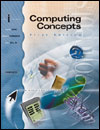Malware
stands for malicious software that is designed by people to
attack some part of a computer system. Two of the most popular
types of malware are viruses and denial-of-service attacks, but
there are many other types. Here we describe some of these (for
more information on these viruses see Harley, David. "Living
with Viruses," Security Management,
August 2000, pp.88-94. See also Gruper, Shimon and Elzam,
Ofer. "Code Red," Security Management
, August 2001, pp. 107-113). Boot sector infectors (BSIs) This type of virus is still around but new versions are
becoming rare because they're more difficult to write than
other types of malware. A BSI infects the master boot record
which has the program that computers with Intel CPUs use to
start up. This malware spreads by one person giving a diskette
to another. Nowadays, e-mail is a more popular propagator of
viruses. File Infectors This type of virus infects executable files like those that
end in .EXE, .COMB, and .DLL. Again it takes diskette swapping
to spread this type of malware, so it's losing
popularity. Macros A macro is a small program that automates repetitive tasks
within software like Word or Excel. Microsoft Office stores
macros inside data files, such as Word documents. Word
documents are swapped more often by users so this type of
malware spreads faster than BSIs or file infectors, even though
it uses the same method of propagation. Worms Worms, as explained in the text, spread by sending
themselves to others automatically, in many cases by using the
Outlook e-mail address book on your computer. This type of
malware has one of the highest profiles, and has been reported
on in news shows and in newspapers and magazines. Trojan Horses A Trojan horse is malware that hides inside some other file
that performs a task that seems desirable to the user. There
are three kinds of Trojans: - the type that steal passwords
- the type that does direct damage
- the joke type that pretends to do damage.
Memetic Viruses A memetic virus is a "virus of the mind." This category of
malware includes - virus hoaxes (also called metaviruses)
- chain letters
- erroneous security alerts
- other nuisance notices
Hybrid Malware Combining one or more of the above types makes for a more
potent type of malware. Anti-Virus Software Anti-virus software looks for and tries to get rid of
different types of viruses like worms and Trojan horses. A worm
spreads by sending itself to everyone in the infected
user's Outlook address book. Trojan horses are hidden like
the Greeks in their mythical wooden horse. The damaging code is
hidden in other software, like a game. Most anti-virus software works continually in the background
checking all files, including e-mail message and attachments as
they arrive. Anti-virus software works by scanning a file and
comparing it to its list of virus signatures. The list is
comprised of all the viruses that the anti-virus software
company knows about and thinks are on the loose. This is the
reason you need to update your anti-virus software very
frequently so that you have the newest virus signatures. But, anti-virus software can sometimes find viruses without
a virus signature. In this case the software uses a method
called heuristics, which means that it looks at how a
particular piece of software acts. Sometimes this leads to a
false positive, which means that the anti-virus software finds
a virus in a file where it doesn't exist. | 



 2002 McGraw-Hill Higher Education
2002 McGraw-Hill Higher Education